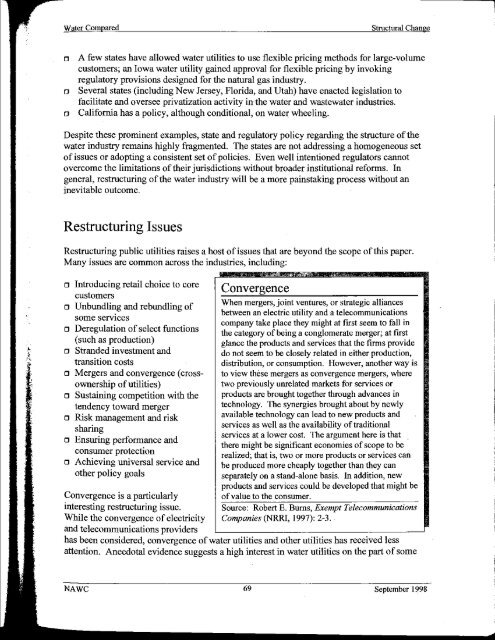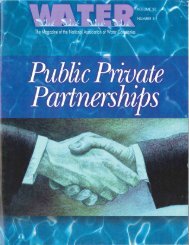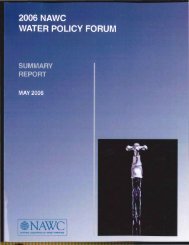BEECHER - NAWC
BEECHER - NAWC
BEECHER - NAWC
Create successful ePaper yourself
Turn your PDF publications into a flip-book with our unique Google optimized e-Paper software.
Water ComparedStructural ChangeoooA few states have allowed water utilities to use flexible pricing methods for large-volumecustomers; an Iowa water utility gained approval for flexible pricing by invokingregulatory provisions designed for the natural gas industry.Several states (including New Jersey, Florida, and Utah) have enacted legislation tofacilitate and oversee privatization activity in the water and wastewater industries.California has a policy, although conditional, on water wheeling.Despite these prominent examples, state and regulatory policy regarding the structure of thewater industry remains highly fragmented. The states are not addressing a homogeneous setof issues or adopting a consistent set of policies. Even well intentioned regulators cannotovercome the limitations of their jurisdictions without broader institutional reforms. Ingeneral, restructuring of the water industry will be a more painstaking process without aninevitable outcome.Restructuring IssuesRestructuring public utilities raises a host of issues that are beyond the scope of this paper.Many issues are common across the industries, including:..._,,.:_ >D Introducing retail choice to corecustomersD Unbundling and rebundling ofsome servicesD Deregulation of select functions(such as production)D Stranded investment andtransition costsD Mergers and convergence (crossownershipof utilities)D Sustaining competition with thetendency toward mergerD Risk management and risksharingD Ensuring performance andconsumer protectionD Achieving universal service andother policy goalsConvergence is a particularlyinteresting restructuring issue.While the convergence of electricityand telecommunications providersConvergenceWhen mergers, joint ventures, or strategic alliancesbetween an electric utility and a telecommunicationscompany take place they might at first seem to fall inthe category of being a conglomerate merger; at firstglance the products and services that the firms providedo not seem to be closely related in either production,distribution, or consumption. However, another way isto view these mergers as convergence mergers, wheretwo previously unrelated markets for services orproducts are brought together through advances intechnology. The synergies brought about by newlyavailable technology can lead to new products andservices as well as the availability of traditionalservices at a lower cost. The argument here is thatthere might be significant economies of scope to berealized; that is, two or more products or services canbe produced more cheaply together than they canseparately on a stand-alone basis. In addition, newproducts and services could be developed that might beof value to the consumer.Source: Robert E. Bums, Exempt TelecommunicationsCompanies (NRRI, 1997): 2-3.has been considered, convergence of water utilities and other utilities has received lessattention. Anecdotal evidence suggests a high interest in water utilities on the part of some<strong>NAWC</strong> 69 September 1998
















